For my upcycling piece, I chose to make an abstract wireframe sculpture. For the body of the structure, I solely used straightened paperclips and rubber bands. The feet are made of Play-Doh.
Inspiration
The initial inspiration for the project was the idea of creating something using simple, repetitive tasks. My mind tends to race, so these tasks are a form of stress relief for me. In the context of this piece, the tasks were creating a roughly 1-inch diameter rubber band ball out of about 100 rubber bands, and straightened-paperclip linkages.
This is where the name “Motion in Static Life” comes from. In order to calm my mind and stay grounded in the moment (static life), I perform simple, repetitive tasks (motion). The name is also inspired by one of my favorite music albums: “Movement in Still Life” by BT.
On the subject of music, rather than following the design loop that I’ve used in every engineering project for the last 7 years, I wanted to follow the workflow I use as a composer. When I write music, I usually pick a style and just go with the flow until I feel like the piece is done. Doing this allows me to be in touch with my emotions and let them influence the piece more than my preconceptions about the end result.
Phase 1 – Getting Started
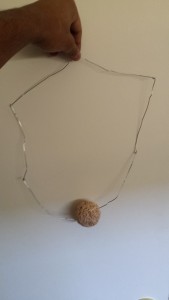
The first thing I did was straighten out 15 to 20 steel paperclips. Next, I used a pair of pliers to bend small hooks onto the end of each paper clip and hooked 6 of them together into one long assembly. At this point, I considered the possibility of immediately proceeding with a 3-dimensional wireframe, but I realized that each connection point had strange degrees of freedom. As I started to build upwards, I noticed that the linkages would rotate in unpredictable directions and the sculpture would continually collapse on itself. So, I moved on to the rubberband ball.
I started by bunching around 10 rubberbands together as a core, then wrapped this core with more rubberbands. Initially, I needed to double them back, but as the ball grew bigger, I was able to wrap them more comfortably. I continued this until I ran out of rubberbands.
Then, I stabbed the ball with the ends of the linkage, and everything stayed intact!
Phase 2 – Laying It Out
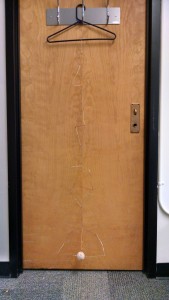
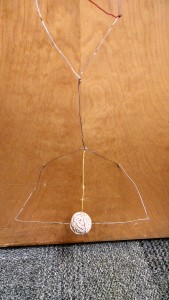
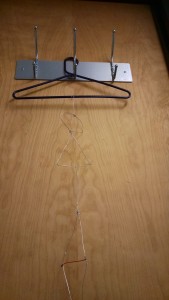
I took the initial linkage-ball assembly, and started adding more layers of paperclip linkages. Each successive layer had one less link in it (5-4-3-2) and a single link connected each layer to the next. No cross braces (colored paperclips) were added until the 6-5-4-3-2 pattern was complete with standard paperclips. On layers that did not have a central connection point, the connecting link was kinked. The picture below shows one such layer (the member above the red link is kinked).
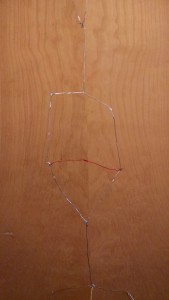
After this initial pattern was completed, I added cross-braces to three layers that were not holding shape well due to the unpredictable degrees of freedom of the connections. In order to easily visualize the whole thing, I hung the piece from a coat-hanger.
Phase 3 – Making it 3-dimensional
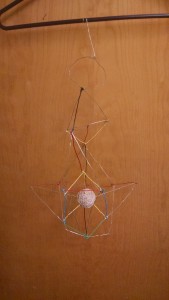
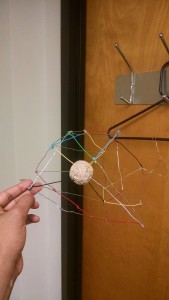

Once complete with Phase II, I started folding each layer up and attaching it to the the next layer using more colored paperclips. I also attached particularly unstable connection points to the rubberband ball. As I was working on it, I realized that the sculpture was starting to remind me of a BCC unit cell. However, because each layer had less links than the last, it quickly evolved into an amorphous shape. I was able to maintain some level of symmetry by using like-colored paperclips across the center from one another. The symmetry is not as apparent as it could be because most of the paperclips were still somewhat kinked and the hooks were all different sizes. This made almost every link a unique length and thus, the sculpture was somewhat lopsided.
Finally, I added rubberbands between wide, unsupported spaces to give the sculpture a bit more strength, and play-doh feet so it could stand up on its own on a table.

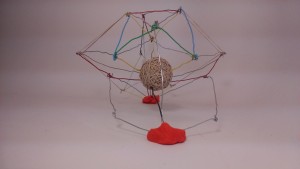
End Result
There are a number of things about this piece that I am content with. I believe that it served its purpose in giving my mind a break from its constant racing, I’m happy that I was able to maintain some amount of symmetry, and I’m happy that it is structurally sound and free standing. I’m also impressed that the design was able to evolve from a line (the initial linkage), to a plane (the coat hanger pattern), to a 3D-object.
That said, I believe the piece could be improved significantly if re-done. Given the “musical” approach I was taking and the fact that it was my first attempt at creating such a sculpture, this is unsurprising to me. I need to ensure that every link used is very straight, of the same length, and has relatively uniform hooks on it. Connection points that have multiple links on it are very challenging, but if the parts are generally uniform, the whole piece will be much more likely to hold symmetry. Additionally, I would not use the 6-5-4-3-2 pattern on layers. I would most likely go with a consistent number (6?), which I also believe could give the piece a more “geometric” appearance. Perhaps I could even attempt to make it resemble something real, like a helicopter!
Plans
I don’t anticipate using any part of this piece in my final project, so it’ll likely be discarded. I will definitely harvest the rubberband ball in case I want to make another wireframe sculpture at some point. I may also keep adding to the rubberband ball to make it even bigger.
2-5-16 NOTE:
I just realized that it kind of looks like a bear when it’s slightly rotated!
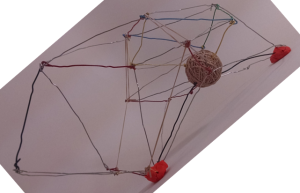


36 Comments. Leave new
That’s pretty awesome, that it turned out how you wanted! I bet you could take a wireframe 3d model and reverse engineer it too. I’m glad that you were able to find a way to aesthetically arrange common household items, and that you got a chance to break free for the regiment of normal engineering.
You took a very unique approach to this project and the final product looks great!
I love the idea of the linear design process. I definitely appreciate that and enjoy the final product. It actually does require a surprising amount of effort to make something that looks so simple. Good work!
Awesome project I really enjoy the look!
I like the combination of metal and rubber. The clay looks a little off, maybe you could mold it more evenly? I like the different colors you used. I think it would be great if you made the ‘heart of the buffalo’ sculpture.
This reminds me of those kinetic apparatuses that help soften the landing and prevent the inside object from breaking. I wish the wires were less wrinkly, but I understand what a pain that can be. Good work with what you had to work with.
Very unique and creative idea! I like how different it looks depending on which way you look at it. Nicely done!
I really like the process that you went through (more of a trial by error and experimentation). If you were to create another, I bet it would turn out totally differently. It does sounds a lot more like creating music!
Interesting process. It feels very modern and I like the complexity within the simplicity. Its cool that it can be interpreted many different ways.
Cool idea and unique approach. I like how you didn’t know exactly what you wanted to do but you stuck with your original materials.
I love how abstract your project is, the structure seems surprisingly sturdy considering what it is made of.
I like your original thought process to use two simple materials and I can very much seem the buffalo. It could be cool to make a whole series of paper clip animals.
This wire structure has some interesting dimensional qualities. It almost has a surrealistic look to it. I like that your design process was directed mostly by chance and spontaneous inspiration.
I really like the stream of consciousness design process. It’s clear from the finished product that you just used whatever you had and made it work. Great job!
I’ve been along for the ride for most of this, so you already know my comments. I’m an advocate for the buffalo, nice finish.
Looks different. Haven’t seen something like this before. Did you have an inspiration? Even though it was random bu it ended up looking nice. I like that its symmetric. With something this abstract you will always have people think differently about it. Good Job.
I did not know the design was dynamic from looking at at first, but that is really amazing how it can “morph” through the linkages. I like your tid-bit about the rubber ball being a stress releiver, kind of a nice hook to start the presentation. This aesthetic and dynamic form you are trying to go for is great. I like the inspiration to maybe continue this as possibly a cool trophy for student athletes.
I like that you took a different approach to your project, it shows a lot of innovation. It’s really interesting to see your design iteration process. I really like the 2-D to 3-D design process. It really adds a level of depth to your design. I really like the amount of different visuals you created that many people can see depending on what angle it’s viewed at.
I like how you took such a different path than everyone else in the class. I think it would be cool if you did something to make it dynamic. As in, using the rubber bands in a “suspension” type system. I also like how everyone sees something different in it, making it personal for every individual.
I like that you took a very creative/free-form approach to the project and just let the project become it’s own thing. I like that you were able to unintentionally make an abstract buffalo. Good work!
I like how the rubber band ball is the only piece in the project that has its color: it draws the eye to the center of the project. I like how you went into the project with an idea and how dynamic your project goal was. It was interesting that people kept seeing different objects.
I really like the free flow design of this project. It totally does have a morphed appearance depending on the angle of attack!
I see the buffalo!
You said that you initially wanted the look to be rather bland for the irony, but I think that the more color the better for this project because of the simpleness of each component.
It’s very interesting to use the rubber band ball as the center/joining hub of the paper clips. I like it. I think visually the sculpture turned out really representative of your design process, which was so organic and free-form.
The linear design approach is amazing, just letting the piece take its own shape. Following an artist approach rather than an engineering style. Has a great space ship/ futuristic feel. Falls into a true art feel, makes everyone see something different. Great work.
This an interesting abstract sculpture and clever use of materials. I like the combination of colors and textures.
It makes a really cool looking mobile. Do you have plans to put it on display anywhere?
I really like your design process. It is super interesting and I love how much thought you put into it. It definitely goes along with the stream of conscious concept. It turned out very interesting. I think it would look really awesome at a larger scale.
I like how you ended up going with your gut the whole process and creating something that appears to be completely random. It lets people decide on their own what they think your final product is. It somewhat reminds me of cloud watching. To some people it can be anything and everything, while to others it could just be a blob. 😀
At one part in your process I saw a fish. Now I see a bull like creature.
Interesting aesthetic, how long did the rubber band ball take you? I have always wanted to create one of those.
Very MOMA! This is abstract and interesting to look at. It looks like something you’d see in a fine art museum. I’m also surprised how durable it looks when you move it. Nicely done!
The concept is pretty cool. I also like the colors of it. I would say use some stiffer wires so that they don’t bend so easily
Interesting sculpture, you certainly nailed the abstract part of it! It’s cool how you related it to the way your mind works as well.
I really liked how you talked about your mentality in relation to this project. I think the best way to fully embrace the concept of simple repetitive tasks would be to just keep expanding on your current design. Just don’t think about where it is going or what it could be used for but just keep going with it and adding random paper clips wherever you feel like adding them in that moment. It might turn out to look really complex and abstract, or it might turn out to look like junk, but if the point of it is to help you relax and provide an escape from engineering life, this could be a great use for your current object! But sometimes a fresh start can also be just as relaxing and helpful as expanding on your current project. Overall, very unique approach to this upcycling project and I think it has potential to be more if you wanted to continue developing it!